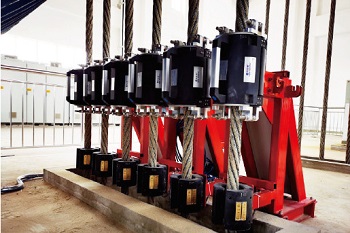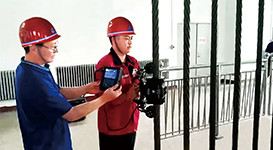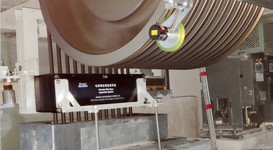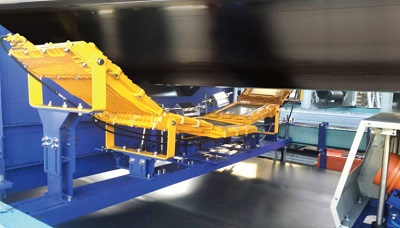
|

|

|

|
Wire rope is a highly dangerous component in mine hoisting equipment. Broken rope accidents caused by a decrease in the wire rope load capacity have repeatedly resulted in serious casualties and property losses. The TCK.W wire rope detection system provides the latest and most reliable technical solution for reliable determination of the safety performance of wire rope, effectively improving the long-standing challenging problem of non-destructive testing of wire rope. Wire rope detection and wire rope detector have always been challenging due to the lack of non-destructive testing technology meeting the requirements of on-site wire rope detection. In the world, the safety of wire rope can only rely on artificial inspection and empirical technical means based on service life for mandatory scrapping, which still has many difficulties in practical operation: (1) It is difficult to find internal broken wires, wear, corrosion and other injuries on the spot; (2) It is difficult to continuously measure the reduction in outer wire diameter on the spot; (3) It is also difficult to accurately measure the elongation of the wire rope on the spot; (4) Blackening, corrosion, pitting and other internal injuries are invisible and can only be qualitatively analyzed, not quantitatively represented. When the wire rope diameter decreases by 10%, how much does the total cross-sectional area of steel wires decrease? Practice has shown that broken wires, wear, corrosion and other injuries can all reduce the total cross-sectional area of steel wires in wire ropes. In the past, due to the lack of wire rope detectors and reliability problems, it is still difficult to achieve the above purposes with the current regulations in practice. Non-destructive tester for wire rope
The TCK.W wire rope non-destructive testing technology is an innovative achievement in China's scientific community for successfully discovering changes and movement patterns in spatial magnetic field vector conditions in wire rope detection applications.
This world-first weak magnetic detection technology is characterized by three innovations and two breakthroughs:
The establishment of the "space magnetic field vector synthesis" theory;
The discovery of the "weak magnetic detection" method;
The invention of the "Dou's element" technology.。
It is precisely based on these three major innovative achievements that TCK.W has successfully solved two major detection problems that have plagued the world of non-destructive testing for a century:
Quantitative detection of various injuries to steel wires;
Accurate assessment of the remaining load-bearing capacity and service life of steel wires.。
The testing effect of TCK.W's new steel wire rope detection device: The TCK.W online non-destructive quantitative detection system for steel wire ropes is based on a special sensor called the Dou's element, which was invented by Chinese famous automation expert Professor Dou Yutang and has never been used internationally before. The theoretical basis for the TCK.W product is the "spatial magnetic field vector synthesis" principle (Dou's principle), which was independently invented by Professor Dou Yutang. Produced by Luoyang Weierluopu Detection Technology Co., Ltd., the TCK.W technology is the only non-destructive quantitative detection device for steel wire ropes that has obtained national recognition and approval for nationwide promotion so far, and has obtained multiple patents such as invention patents and utility model patents. Now, the following analysis will be conducted on the detection and use of the TCK.W steel wire rope detection system in our mine.
In November 2007, our mine used the TCK.W steel wire rope detection device for on-site testing in the main shaft. First, the weak magnetic loading instrument was used to charge the magnetic field, and then the detection device was used for testing. The broken wires, wear, corrosion, and stretching of the steel wires can all be detected on the instrument. The operation is simple, and the test results can be printed out or displayed on the detection device. The test result showed normal use, suggesting strengthened maintenance, and the test result was in good agreement with the actual damage condition of our mine's steel wire rope. This device brought great convenience to our daily maintenance personnel and greatly improved the detection efficiency and accuracy.
Conclusion: The TCK.W steel wire rope damage quantitative detection system is simple and convenient to operate, requiring only one person. The instrument can not only qualitatively analyze but also quantitatively detect damage such as broken wires, wear, corrosion, and fatigue in steel wires, accurately predicting the service life of steel wires and reliably preventing wire rope accidents. This has effectively improved the operation efficiency of steel wires and greatly reduced significant losses caused by broken wires.
Currently, the first trial of this instrument has been implemented among the sister companies of China Coal Jinhai Ocean Group Corporation, yielding excellent results and incalculable economic and social benefits. Additionally, practice has confirmed that only by accurately detecting the wire ropes of winches in accordance with the requirements of the "Coal Mine Safety Regulations" can we ensure the safe operation of winches.
The application of TCK.W wire rope detection technology in academic journals
Editor's note: TCK.W has developed a weak magnetic rope detection technology that can real-time monitor the status of steel ropes 24 hours a day, 365 days a year, and locate, classify, and quantitatively identify various internal and external defects. Currently, more than 2,500 clients in 42 countries worldwide are using this technology. These clients have published papers on the safety and economic benefits brought about by this new technology in various academic journals. Here is a compilation of some of these papers for experts and scholars to explore and study in depth.。
论文名称
作者单位

 publish:《economic technology》
publish:《economic technology》